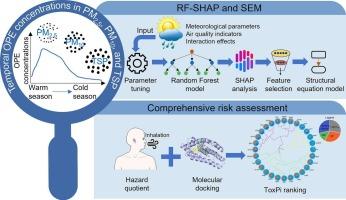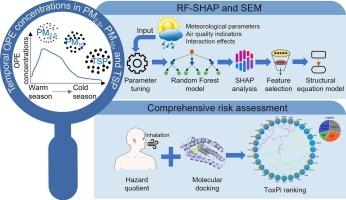One-year dynamics of atmospheric organophosphate esters: Size-fractionated distribution, seasonal trends, and machine learning-based driver identification
IF 9.7
1区 环境科学与生态学
Q1 ENVIRONMENTAL SCIENCES
引用次数: 0
Abstract
Organophosphate esters (OPEs) have increasingly raised global concern due to their pervasive presence in airborne particles and potential risks they pose to human health. This study systematically characterized OPE concentrations in PM2.5, PM10, and TSP over a one-year period. The results revealed that OPEs preferentially partitioned to smaller particles and displayed higher total concentrations during the warm season. Among alkyl-, halogenated-, and aryl-OPEs, halogenated-OPEs exhibited the highest concentrations while aryl-OPEs ranked highest in ToxPi-based prioritization. To identify key environmental drivers, Random Forest model combined with SHAP analysis and structural equation model were employed. The RF-SHAP model demonstrated higher explanatory power for halogenated-OPEs compared to alkyl- and aryl-OPEs, with temperature, atmospheric pressure, and the interaction effect of temperature and relative humidity identified as dominant influencing factors. Furthermore, the findings suggest that OPEs may undergo atmospheric transformation under complex environmental conditions. Overall, this study provides a comprehensive understanding of the particle-size distribution, temporal dynamics, environmental determinants, and health risk profiles associated with particle-bound OPEs. These insights are invaluable for informing future regulations concerning emerging contaminants in the atmosphere.


大气有机磷酸酯的一年动态:大小分异分布、季节趋势和基于机器学习的驱动因素识别
有机磷酸酯(OPEs)由于普遍存在于空气中的颗粒中,并对人类健康构成潜在风险,已日益引起全球关注。本研究系统地描述了一年内PM2.5、PM10和TSP中OPE的浓度。结果表明,在暖季,OPEs优先向较小的颗粒分裂,且总浓度较高。在烃基、卤代和芳基opes中,卤代opes的浓度最高,芳基opes的浓度最高。为了识别关键环境驱动因素,采用随机森林模型结合SHAP分析和结构方程模型。RF-SHAP模型对卤化opes的解释能力高于烷基opes和芳基opes,其中温度、大气压以及温度和相对湿度的相互作用是主要影响因素。此外,研究结果表明,OPEs可能在复杂的环境条件下发生大气转化。总的来说,这项研究提供了对颗粒大小分布、时间动态、环境决定因素以及与颗粒结合的OPEs相关的健康风险概况的全面了解。这些见解对于通知有关大气中新出现的污染物的未来法规是非常宝贵的。
本文章由计算机程序翻译,如有差异,请以英文原文为准。
求助全文
约1分钟内获得全文
求助全文
来源期刊

Environment International
环境科学-环境科学
CiteScore
21.90
自引率
3.40%
发文量
734
审稿时长
2.8 months
期刊介绍:
Environmental Health publishes manuscripts focusing on critical aspects of environmental and occupational medicine, including studies in toxicology and epidemiology, to illuminate the human health implications of exposure to environmental hazards. The journal adopts an open-access model and practices open peer review.
It caters to scientists and practitioners across all environmental science domains, directly or indirectly impacting human health and well-being. With a commitment to enhancing the prevention of environmentally-related health risks, Environmental Health serves as a public health journal for the community and scientists engaged in matters of public health significance concerning the environment.
 求助内容:
求助内容: 应助结果提醒方式:
应助结果提醒方式:


